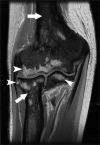Erdheim-Chester disease: MR imaging, anatomic, and histopathologic correlation of orbital involvement
- PMID: 15090356
- PMCID: PMC7975611
Erdheim-Chester disease: MR imaging, anatomic, and histopathologic correlation of orbital involvement
Abstract
Erdheim-Chester disease (ECD) is a rare form of histiocytosis of unknown origin characterized by tissue infiltration by lipid-laden histiocytes. Typically, the diaphyseal and metaphyseal portions of the tubular bones are affected, leading to a characteristic radiographic pattern of bone sclerosis. Orbital involvement is not infrequent and is manifested by exophthalmos and periorbital xanthomatous lesions, with associated visual problems. This case report documents imaging and pathologic findings in a patient with ECD with extensive orbital involvement.
Figures



Similar articles
-
[Erdheim-Chester disease of the orbit with compressive optic neuropathy].Ophthalmologe. 2010 Mar;107(3):266-9. doi: 10.1007/s00347-009-2041-y. Ophthalmologe. 2010. PMID: 19777245 German.
-
[Erdheim-Chester histiocytosis - a rare differential diagnosis].Rofo. 2011 Apr;183(4):319-22. doi: 10.1055/s-0031-1274610. Epub 2011 Apr 5. Rofo. 2011. PMID: 21469056 Review. German. No abstract available.
-
[Imaging features of osseous and extra-osseous involvement in Erdheim-Chester disease].J Radiol. 2011 Jul-Aug;92(7-8):671-80. doi: 10.1016/j.jradio.2011.04.013. Epub 2011 Jul 5. J Radiol. 2011. PMID: 21819909 Review. French.
-
[Erdheim-Chester disease as differential diagnosis in bilateral exophthalmos].Klin Monbl Augenheilkd. 2004 Nov;221(11):960-3. doi: 10.1055/s-2004-813771. Klin Monbl Augenheilkd. 2004. PMID: 15562361 German.
-
Unusual orbital involvement in Erdheim Chester disease: a radiological diagnosis.Orbit. 2012 Oct;31(5):338-40. doi: 10.3109/01676830.2012.678917. Epub 2012 May 25. Orbit. 2012. PMID: 22631449
Cited by
-
Resolved heart tamponade and controlled exophthalmos, facial pain and diabetes insipidus due to Erdheim-Chester disease.BMJ Case Rep. 2018 Oct 17;2018:bcr2018225224. doi: 10.1136/bcr-2018-225224. BMJ Case Rep. 2018. PMID: 30337283 Free PMC article.
-
Erdheim-Chester disease: look it in the eye. An orbital magnetic resonance imaging study.Haematologica. 2022 Nov 1;107(11):2667-2674. doi: 10.3324/haematol.2021.280510. Haematologica. 2022. PMID: 35484665 Free PMC article.
-
Utility of MR spectroscopy and MR perfusion in characterizing intracranial pathology in Erdheim-Chester disease: A case report.Radiol Case Rep. 2024 Aug 28;19(11):5332-5335. doi: 10.1016/j.radcr.2024.08.008. eCollection 2024 Nov. Radiol Case Rep. 2024. PMID: 39280736 Free PMC article.
-
CT and MR imaging of orbital inflammation.Neuroradiology. 2018 Dec;60(12):1253-1266. doi: 10.1007/s00234-018-2103-4. Epub 2018 Oct 11. Neuroradiology. 2018. PMID: 30310941 Free PMC article. Review.
-
Choroidal mass as the first presentation of Erdheim-Chester disease.Am J Ophthalmol Case Rep. 2019 Aug 9;16:100539. doi: 10.1016/j.ajoc.2019.100539. eCollection 2019 Dec. Am J Ophthalmol Case Rep. 2019. PMID: 31463417 Free PMC article.
References
-
- Veyssier-Belot C, Cacoub P, Caparros-Lefebvre D, et al. Erdheim-Chester disease: clinical and radiological characteristics of 59 cases. Medicine (Balt) 1996;75:157–169 - PubMed
-
- Chester W. Uber Lipoidgranulomatose. Virchows Archiv 1930;279:561–602
-
- Jaffe HL. Metabolic, Degenerative and Inflammatory Diseases of Bones and Joints. Munich: Urban and Schwarzenberg;1970. :531–541
Publication types
MeSH terms
LinkOut - more resources
Full Text Sources
Medical
